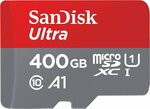SanDisk 400GB Ultra microSDXC UHS-I Memory Card with Adapter - 120MB/s, C10, U1, Full HD, A1, Micro SD Card down to $59 delivered.
Best price on Amazon according to CamelCamelCamel
About this item
- Ideal for Android smartphones and tablets, and MIL cameras
- Up to 400GB to store even more hours of Full HD video(2) | 1GB=1,000,000,000 bytes. 1TB=1,000,000,000,000 bytes. Actual user storage less. | (2)Full HD (1920x1080) video support may vary based upon host device, file attributes, and other factors. See official SanDisk website.
- Up to 120MB/s transfer speeds let you move up to 1000 photos in a minute(5) | Up to 120MB/s read speed, engineered with proprietary technology to reach speeds beyond UHS-I 104MB/s, require compatible devices capable of reaching such speed. Write speeds lower. Based on internal testing; performance may be lower depending on host device, interface, usage conditions and other factors. 1MB=1,000,000 bytes. | (5)Based on internal testing on images with an average file size of 3.55MB (up to 3.7GB total) with USB 3.0 reader. Your results will vary based on host device, file attributes, and other factors.
- Load apps faster with A1-rated performance(1) | (1)A1 performance is 1500 read IOPS, 500 write IOPS. Based on internal testing. Results may vary based on host device, app type and other factors.
- 10-year manufacturer warranty (See official SanDisk website for more details regarding warranty in your region.)




 CamelCamelCamel
CamelCamelCamel
Is this good for Switch Oled? I just got one and was considering doing the digital route for my main games.